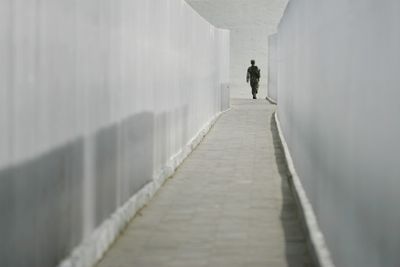Poor U.S. economy deterring illegal immigrants from Mexico
Border Patrol says number of arrests has fallen sharply

SAN LUIS RIO COLORADO, Mexico – Arrests of illegal immigrants on the U.S.-Mexico border have fallen to levels unseen since the 1970s, as the ailing U.S. economy and enhanced enforcement appear to be deterring people from embarking on treks north.
The trend is apparent from San Diego to Brownsville, Texas, but is felt most dramatically on the border’s busiest illegal immigrant corridors, which extend through the Mexican state of Sonora to Arizona and California.
In the sleepy Sonoran town of San Luis Rio Colorado, the migrants who once streamed through have all but disappeared. Piles of donated clothing spill from a closet at the town’s migrant shelter and shoeshine boys outnumber slumbering immigrants at Benito Juarez plaza.
Just across the border in Yuma County, Ariz., there are days when U.S. Border Patrol agents don’t arrest anyone, an almost unthinkable prospect three years ago when the area was the busiest illegal crossing point into the country, with thousands of immigrants flooding across on some days.
“We were in shock,” said Ben Vik, a U.S. Border Patrol spokesman, referring to the two days in December when no apprehensions were reported in the patrol sector that protects 126 miles of the frontier.
From October 2008 through February, the Border Patrol arrested 195,399 illegal immigrants, a 24 percent decrease from the same period last year when there were 257,861 arrests. At this pace, the apprehension level will dip for this federal fiscal year to its lowest level since 1975, when 596,796 immigrants were caught, according to U.S. Border Patrol statistics.
The downward trend in apprehensions – considered one of the best indicators of illegal immigrant migration – began about three years ago, about the same time the federal government started fortifying the border with more agents, fencing and infrastructure.
The border enhancements weren’t enough on their own to stop immigrants from entering the country. But with the U.S. economy now in a tailspin, few incentives remain for immigrants to endure the increasingly difficult crossings.
“A lot of people who would have come here illegally and stayed illegally are not bothering to come to the U.S.,” said Demetrios Papademetriou, president of the Migration Policy Institute, a Washington, D.C.-based think tank. “The information that they are getting basically says there are no opportunities here.”
Many immigrants still try. For them, America’s economic troubles seem trifling compared with the meager salaries at home. But the downward trend breaks with past immigration patterns, when federal crackdowns in one place only led immigration flows to shift to other areas.